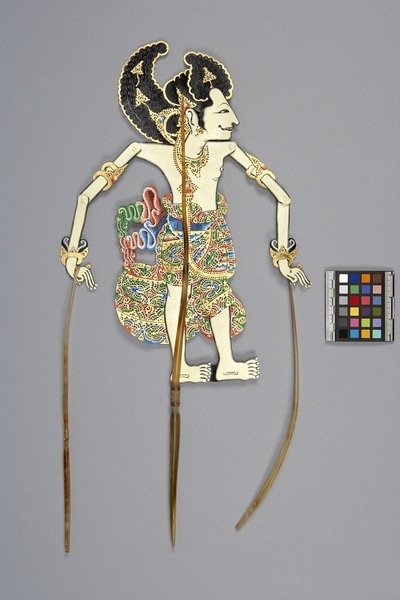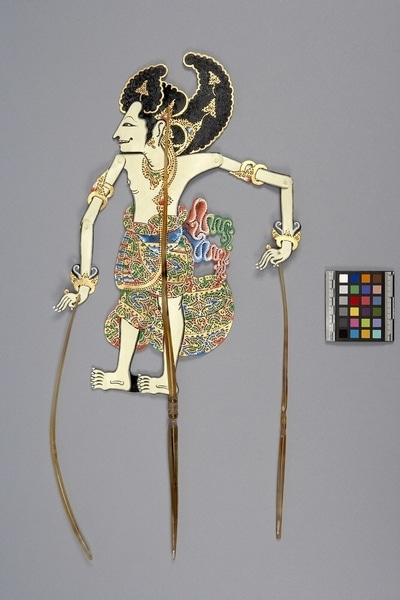Shadow Puppet Item Number: 1374/29 from the MOA: University of British Columbia


Description
A flat tall puppet painted yellow-white. Represents the character Arjuna, Pandhawa Prince. There are red eyes and the three upper teeth are white. The curly black hair curves backward and upward, and are tinged with gold along the edges. The lower garment is finely perforated with a red, green, blue, and gold design. The feet and the head face to the puppet's right. There is a gold necklace with a green pendant. Two gold shoulder rings and a bracelet are on each arm. The shoulders and the elbows are rotatable and a marionette stick is attached through the palm of each hand.
History Of Use
Wayang kulit was established on Bali, when the Hindu Majapahit Court moved there in the 16th century, from neighbouring Java, after the first Islamic sultanate had been established. A dynamic living art, over the centuries, Balinese wayang kulit has developed its own distinctive aesthetic, with more realistic looking human characters. The stories performed are frequently drawn from the Mahabharata, with an extensive cast of gods, heroes, villains, ogres and demons.
Iconographic Meaning
The use of colour is highly symbolic: it communicates the personalities and qualities of the puppets. Kresna (an avatar of Wisnu) is first painted white to characterize his spiritual purity, and then painted either green or blue, which symbolizes intelligence, harmony and courage. In contrast, Bima, the second Pandhawa brother, is painted red; a colour associated with tempestuousness, boldness and strength.
Item History
- Made in Bali, Indonesia ? before September 1989
- Collected by Dominique Major
- Owned by Dominique Major before October 17, 1989
- Received from Dominique Major (Seller) and Museum of Anthropology Shop Volunteers (Funding source) on October 17, 1989
What
- Name
- Shadow Puppet
- Identification Number
- 1374/29
- Type of Item
- puppet
- Material
- water buffalo skin, horn, fibre and pigment
- Overall
- height 81.0 cm, width 20.0 cm, depth 2.0 cm
Who
- Culture
- Balinese ?
- Field Collector
- Dominique Major
- Previous Owner
- Dominique Major
- Received from
- Dominique Major (Seller) and Museum of Anthropology Shop Volunteers (Funding source)
Where
- Holding Institution
- MOA: University of British Columbia
- Made in
- Bali, Indonesia ?
When
- Creation Date
- before September 1989
- Ownership Date
- before October 17, 1989
- Acquisition Date
- on October 17, 1989
Other
- Condition
- good
- Accession Number
- 1374/0029